The Conductive Inks Market is estimated to be valued at USD 3.6 billion in 2025 and is projected to reach USD 5.4 billion by 2035, registering a compound annual growth rate (CAGR) of 4.3% over the forecast period.
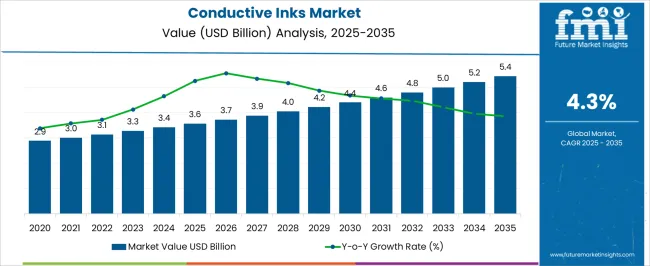
| Metric | Value |
|---|---|
| Conductive Inks Market Estimated Value in (2025 E) | USD 3.6 billion |
| Conductive Inks Market Forecast Value in (2035 F) | USD 5.4 billion |
| Forecast CAGR (2025 to 2035) | 4.3% |
The conductive inks market is experiencing significant growth, driven by the increasing demand for flexible electronics, printed circuits, and energy-efficient solutions in multiple industries. Rising adoption of wearable devices, smart packaging, solar energy systems, and automotive electronics is accelerating the need for high-performance conductive materials. Technological advancements in ink formulation, such as enhanced conductivity, adhesion, and compatibility with diverse substrates, are further expanding application potential.
The market is also influenced by the push for sustainable and lightweight electronics that reduce material waste and production costs. Growing investments in renewable energy and portable electronics have reinforced demand for conductive inks that can support scalable and cost-effective manufacturing processes.
Additionally, the ability to integrate these inks into additive manufacturing and printing technologies is opening new opportunities in advanced electronics and IoT applications As industries continue to focus on miniaturization, energy efficiency, and flexible electronic solutions, the conductive inks market is expected to maintain steady growth, with innovative formulations enabling broader adoption across emerging and mature markets.
The conductive inks market is segmented by type, application, and geographic regions. By type, conductive inks market is divided into Silver Conductive Inks, Carbon Conductive Inks, Silver Nano Inks, Silver Chloride Inks, Dielectric Inks, and Copper/ Copper Oxide Inks. In terms of application, conductive inks market is classified into Solar Panels, Sensors, Biosensors, Touch Screen, Antenna, Printed Heaters, Potentiometers And PCBs (Printed Circuit Board), and Electroluminescent (EL) Panel. Regionally, the conductive inks industry is classified into North America, Latin America, Western Europe, Eastern Europe, Balkan & Baltic Countries, Russia & Belarus, Central Asia, East Asia, South Asia & Pacific, and the Middle East & Africa.
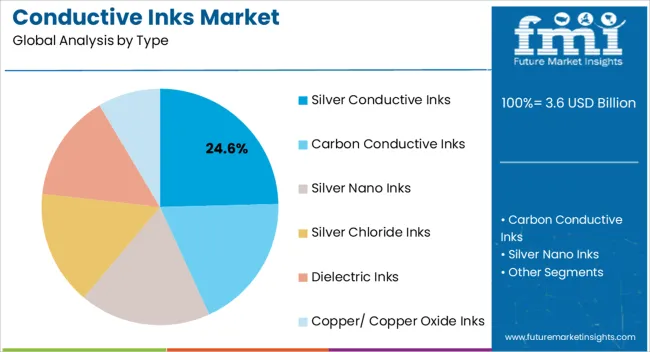
The silver conductive inks segment is projected to hold 24.6% of the conductive inks market revenue share in 2025, establishing it as a leading type in the market. Its dominance is being driven by superior electrical conductivity, excellent thermal stability, and reliable adhesion properties, which make it suitable for high-performance electronic applications. The segment is being increasingly adopted in printed circuit boards, RFID tags, sensors, and flexible electronics where consistent conductivity is critical.
Silver inks also support precision printing and high-resolution patterning, enabling the fabrication of compact and efficient electronic components. The high reliability and performance of silver conductive inks under varying environmental conditions have further reinforced their preference among manufacturers.
Ongoing developments in cost-effective formulations and nanoparticle-based dispersions are enhancing performance while addressing cost concerns As demand for high-efficiency electronic devices and advanced manufacturing techniques grows, silver conductive inks are expected to maintain a significant market position, driving innovation across multiple applications.
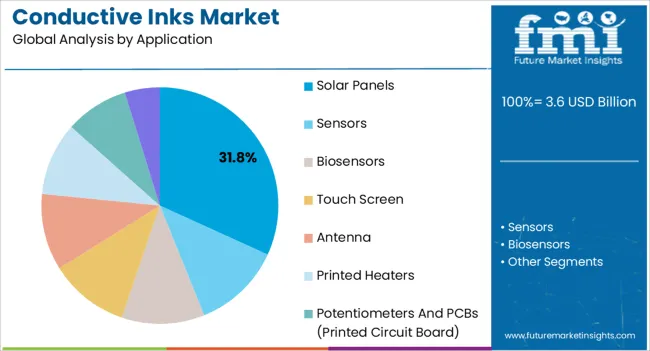
The solar panels application segment is expected to account for 31.8% of the conductive inks market revenue share in 2025, making it the leading application area. Its leadership is being influenced by the increasing global adoption of solar energy systems to support renewable energy goals and reduce carbon emissions. Conductive inks are being used extensively in solar cells for interconnections, electrode formation, and efficiency optimization.
The ability to print conductive patterns with precision reduces material consumption, production time, and overall manufacturing costs, enhancing their appeal to solar panel manufacturers. Ongoing improvements in ink formulations, including higher conductivity and compatibility with various photovoltaic substrates, are driving broader adoption.
Strong government initiatives and incentives to promote solar energy deployment in multiple regions are further stimulating demand for conductive inks in this application As solar installations continue to expand globally, the use of conductive inks for efficient and cost-effective solar panel manufacturing is expected to sustain the segment’s leadership in the market.
Growth in the demand for conductive inks is driven by:
The ever-increasing price of silver has made it imperative to find alternatives to or significantly reduce reliance on the precious metal. Due to its unpredictable price, silver has been replaced by more affordable conductive metals like copper, graphene, and aluminum. Potential market expansion is hampered since the alternatives supplied cannot compete with silver's superior attributes. Limiting silver's use in silver-based inks may slow the market because of its expected price increase throughout the projection period.
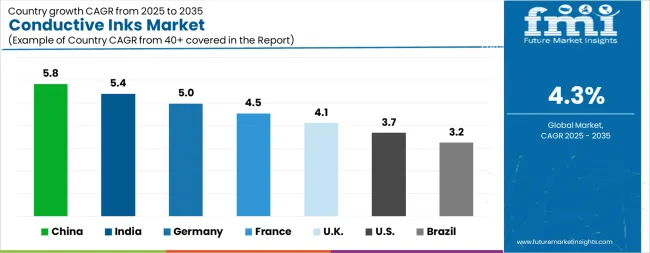
| Country | CAGR |
|---|---|
| China | 5.8% |
| India | 5.4% |
| Germany | 5.0% |
| France | 4.5% |
| UK | 4.1% |
| USA | 3.7% |
| Brazil | 3.2% |
The Conductive Inks Market is expected to register a CAGR of 4.3% during the forecast period, exhibiting varied country level momentum. China leads with the highest CAGR of 5.8%, followed by India at 5.4%. Developed markets such as Germany, France, and the UK continue to expand steadily, while the USA is likely to grow at consistent rates. Brazil posts the lowest CAGR at 3.2%, yet still underscores a broadly positive trajectory for the global Conductive Inks Market. In 2024, Germany held a dominant revenue in the Western Europe market and is expected to grow with a CAGR of 5.0%. The USA Conductive Inks Market is estimated to be valued at USD 1.3 billion in 2025 and is anticipated to reach a valuation of USD 1.9 billion by 2035. Sales are projected to rise at a CAGR of 3.7% over the forecast period between 2025 and 2035. While Japan and South Korea markets are estimated to be valued at USD 193.5 million and USD 123.5 million respectively in 2025.
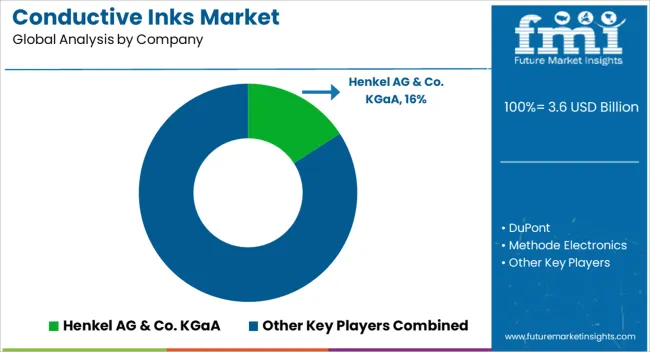
| Item | Value |
|---|---|
| Quantitative Units | USD 3.6 Billion |
| Type | Silver Conductive Inks, Carbon Conductive Inks, Silver Nano Inks, Silver Chloride Inks, Dielectric Inks, and Copper/ Copper Oxide Inks |
| Application | Solar Panels, Sensors, Biosensors, Touch Screen, Antenna, Printed Heaters, Potentiometers And PCBs (Printed Circuit Board), and Electroluminescent (EL) Panel |
| Regions Covered | North America, Europe, Asia-Pacific, Latin America, Middle East & Africa |
| Country Covered | United States, Canada, Germany, France, United Kingdom, China, Japan, India, Brazil, South Africa |
| Key Companies Profiled | Henkel AG & Co. KGaA, DuPont, Methode Electronics, Creative Materials Inc., Nano Dimension, Conductive Compounds, Inc., TEKRA, A Division of EIS, Inc., Sigma-Aldrich Co. LLC., Novacentrix, Inkron, and TOYO INK GROUP |
The global conductive inks market is estimated to be valued at USD 3.6 billion in 2025.
The market size for the conductive inks market is projected to reach USD 5.4 billion by 2035.
The conductive inks market is expected to grow at a 4.3% CAGR between 2025 and 2035.
The key product types in conductive inks market are silver conductive inks, carbon conductive inks, silver nano inks, silver chloride inks, dielectric inks and copper/ copper oxide inks.
In terms of application, solar panels segment to command 31.8% share in the conductive inks market in 2025.
Explore Similar Insights

Thank you!
You will receive an email from our Business Development Manager. Please be sure to check your SPAM/JUNK folder too.
Chat With
MaRIA